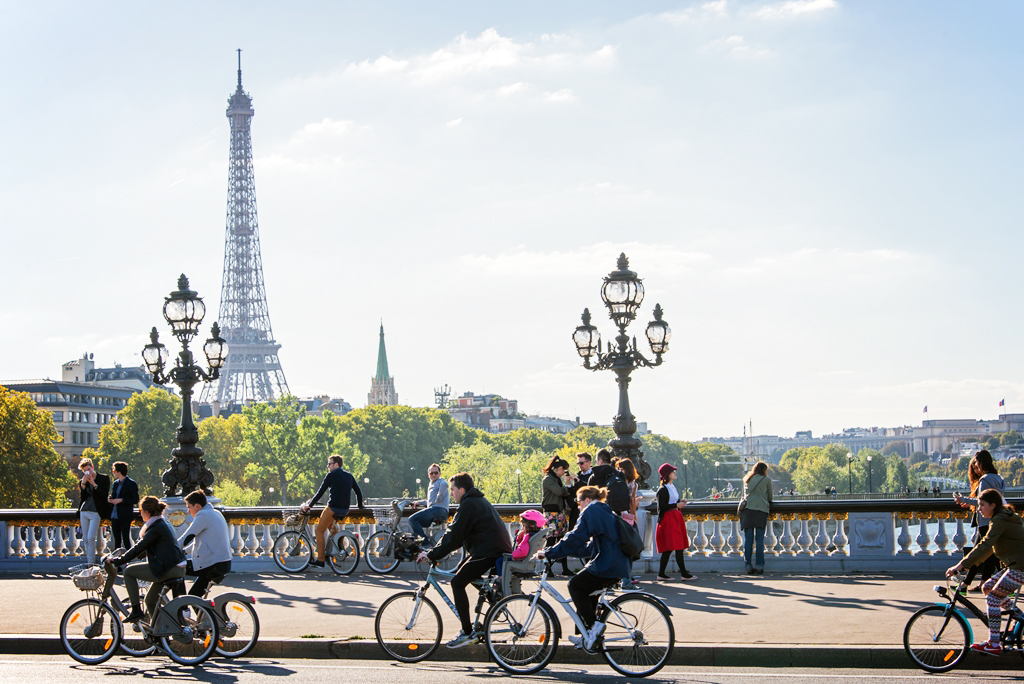
ACROSS EUROPE, CITIES ARE TAKING URGENT STEPS TO CUT RISING LEVELS OF AIR POLLUTION FROM CONGESTED URBAN AREAS.
While poor air quality is far from the toxic levels seen in cities such as Beijing, it’s fast becoming a cause for concern. Earlier this year, the European Commission issued warnings for a number of countries where legal limits are regularly exceeded in major cities, including Germany, France, Spain, Italy, and the UK.
And for good reason. According to the recent Air Quality in Europe report from the European Environment Agency (EEA), air pollution causes 467,000 premature deaths across the continent annually. People in urban areas are most at risk, with 85 percent exposed to fine particulate matter at harmful levels.
Indeed, European cities have some of the world’s highest levels of nitrogen dioxide (NO2), because diesel engines—until recently given preference thanks to reduced CO2 emissions—produce large amounts of the gas. When inhaled, it can cause asthma, heart disease, and lung cancer.
Taking new courses of action
Confronted with mounting evidence and final warnings, Europe’s cities have launched a variety of initiatives to tackle the problem head on.
“Each city is different, with its own constellation of geographic, meteorological, and industrial conditions,” says Franz Jenowein, JLL’s Director of Global Sustainability Research. Proposed solutions are similarly varied. “We’re seeing schemes such as car-free zones, preferential treatment for electric vehicles, and pruning high-emitting vehicles from the road.”
London, for example, is planning the world’s first Ultra Low Emissions Zone (ULEZ), which will initially cover the existing congestion charge zone. Slated for roll-out in 2019, the ULEZ will apply to petrol cars below Euro 4 standards and diesel vehicles below Euro 6 standards, with a daily fee starting at £12.50 for cars and going up to £100 for buses and HGVs.

Triomphe during a car-free day in Paris. Image from PPMC.
The scheme is expected to cut almost 50 percent in emissions of nitrogen oxides in 2020. However, according to Jenowein, this brings its own set of issues related to housing and affordability in the city core. “As rent in the city rises, people move to the suburbs. But when they travel back, they are faced with public transport expenses or congestion charges. It’s tricky to manage purely through markets,” he says.
In Paris, the aim is to halve car numbers by pedestrianizing the city center. A thoroughfare flanking the Seine is slated for permanent closure, and restrictions are planned for two main roads that run from east to west across the city. In parallel, Mayor Anne Hidalgo announced an electric tramway to provide an emissions-free alternative along the route.
Taking cars off the roads
Some cities are going even further. Oslo is set to ban all private cars from its roads by 2019, while investing in public transport and over 35 miles of bike lanes.
Ljubljana closed its old town area to motorized vehicles back in 2007. With priority given to pedestrians, cyclists and public transport, the city center has transformed into a thriving cultural meeting point.
Another option is to limit the volume of traffic. Thanks to its setting in a valley surrounded by mountains, Sarajevo suffers from smog. In December 2016, the authorities restricted vehicle use in the city, allowing alternating odd-even license plates on the road each day.

The Netherlands is taking a slightly different tack, with an outright ban on sales of petrol and diesel fueled vehicles from 2025. Instead, only zero-emissions vehicles such as those powered by electricity or hydrogen will be available for purchase. Despite opposition, the Dutch parliament voted in favor of the move in June 2016. Germany has set a target of 2030 for a similar initiative.
A key barrier to this approach is cost. For change to take place, electric cars need to be affordable. Germany’s solution is to kickstart the revolution through subsidies, offering a €4,000 to buyers who choose an electric vehicle.
In addition, for the switch to electric vehicles to be meaningful, it must be accompanied by a transition to renewable energy. “If we electrify mobility but can’t decarbonize power generation, we may end up subsidising coal-fired power plants,” warns Jenowein. “A systemic approach is very important.”
Likewise, replacements in the form of sustainable, reliable, and affordable alternatives, such as bike lanes and low-emitting public transport are essential. “Ultimately it’s a question of money and governance,” says Jenowein. “It’s not just about remit but also whether you can finance good ideas.”
How real estate can help
The built environment can also contribute to reducing air pollution. Green walls and roofs that absorb polluting substances have become commonplace in cities across the world. Free-to-use or minimal-cost charging stations within central urban areas also make electric vehicles more visible and feasible.
In spite of complex challenges in implementing air-pollution-reducing measures, they can bring unexpected benefits. In Madrid, following an emergency nine-day vehicle ban on Gran Via, businesses along the major thoroughfare noted a 15 percent increase in turnover during the period compared to the previous year.
For residents, clean cities bring obvious health gains. Those living in pedestrianized areas also enjoy reduced noise pollution.
Yet, as Jenowein points out, vehicle-free zones bring a new set of considerations in urban planning. “You have to be careful not to favour one portion of the population and restrict access to those with limited mobility, such as the elderly, disabled, and parents with children,” he concludes. “Everyone should benefit.” 
This article was reprinted in its entirety from Real Views, a news site from JLL that features stories exploring the world of real estate and its impact on the wider business world. Read the original article here. Topmost image from Shutterstock.

